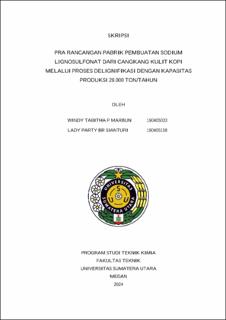| dc.description.abstract | Indonesia is known as an agricultural country that still makes agriculture a source of livelihood for its population. The potential biomass produced from agricultural waste in Indonesia includes the food crop sector and the plantation sector. One of the biomass from the plantation sector that can be utilized is coffee. With the amount of coffee produced, of course, a lot of waste is also produced in the form of coffee skin shells. During this time, the shell of the coffee skin is thrown away because it is considered less useful and worthless. The lignin content in coffee skin shells has the potential to be utilized into products that have a higher value, one of which is as raw material for making sodium lignosulfonate (SLS) by utilizing the delignification process. Therefore, it is necessary to establish a sodium lignosulfonate manufacturing plant to support the coffee hilization program, increase foreign exchange and reduce imports of sodium lignosulfonate from abroad. The main processes in the pre-design of sodium lignosulfonate plant from coffee skin shells include raw material preparation, reaction stages and sodium lignosulfonate purification stages. The location of the plant is planned in Karawang Regency, West Java Province, Indonesia with a total land area of 22,545 m2 and the total workforce required in running the plant is 178 employees with business materials in the form of a Limited Liability Company (PT). The organizational structure used is line and staff. The establishment and operation of the factory requires an investment capital of IDR 1,354,779,973,823 with production costs of IDR 906,451,612,702 and sales proceeds of IDR 1,196,363,421,583 which produces a profit after tax of IDR 187,698,317,780. Based on economic analysis, this plant has a PM of 22.66%; BEP of 34.31%; ROI of 14.17%; POT of 7.6 years; RON of 23.61%; and IRR of 19.85%. Based on the results of economic analysis, the plant is feasible to establish. | en_US |


